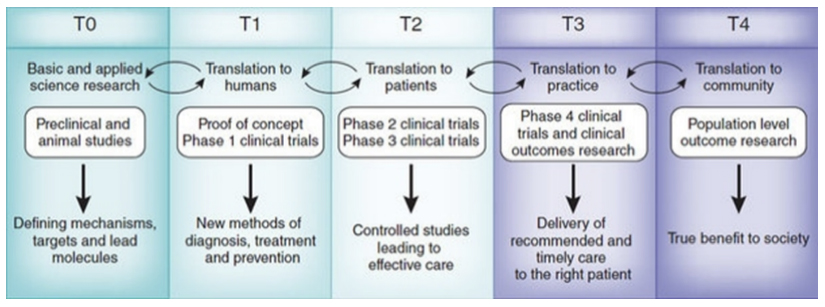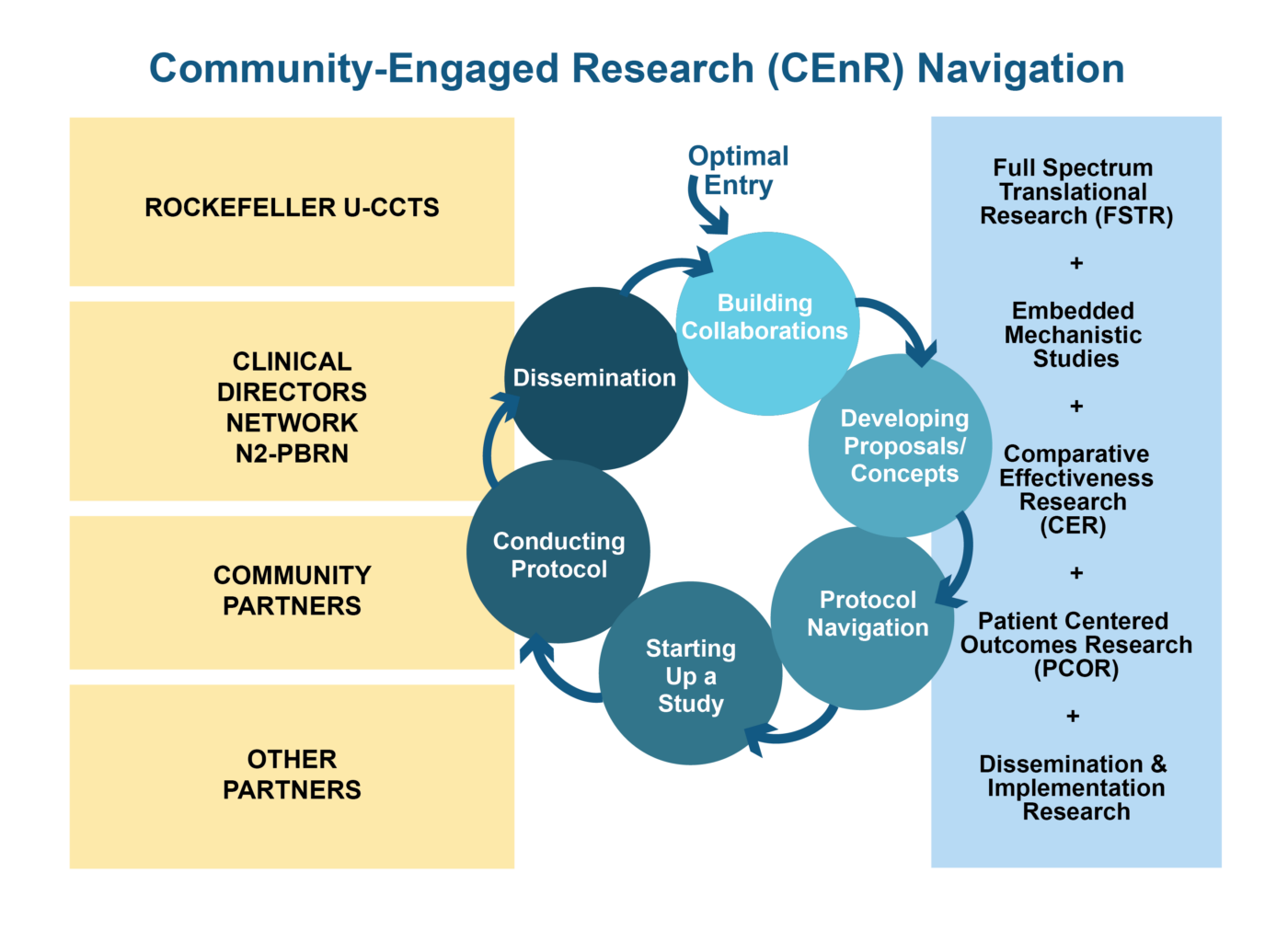Community-Engaged Research - The Basics
The Community Engagement Core at Rockefeller University collaborates with our communities to improve health by designing and conducting Community-Engaged Research together.
Community-Engaged Research (CEnR) is an approach to conducting research projects with varying levels of community engagement. Community Engagement is the process of working together with groups of people who are connected in some way– they may live close together or share a similar situation that affects their wellbeing (CDC 1997).
In CEnR, the level of collaboration may be different for each project. The specifics of a partnership depend on many factors such as the community context, experience and background of the researchers, capacity of the community-based organization, etc. We strive to expand the knowledge and tools of all the collaborators and foster equitable partnerships.
- CEnR addresses topics that are important to the community. It is a core principle that the people affected by the research topic be involved in the design of the research project and developing the solution.
- CEnR recognizes and builds on existing community capacity. Projects work with existing community organizations to address community issues.
- Partnerships are built on mutual trust, respect, cooperation, and commitment. They require time and attention and evolve from feedback.
- Partnerships combine knowledge with action. By involving community, these partnerships can produce research results that can directly translate to improved health for community members.
- Researchers and community partners negotiate terms of engagement for research partnerships. This way, they share a common understanding of expectations, roles, responsibilities, and resources.
The NIH National Center for Advancing Translational Sciences (NCATS) defines Translational Science as “the process of turning observations in the laboratory, clinic, and community into interventions that improve the health of individuals and populations – from diagnostics and therapeutics to medical procedures and behavioral interventions.” This broad range of scientific approaches in translational research is seen as occurring across a spectrum (T0 to T4, below).
Our community-engaged research projects occur across multiple stages, bridging the entire spectrum of translational research.
The following figure illustrates the stages in the Translational Research Spectrum:

Figure adapted from Blumberg et al. 2012
Biomedical and health research occurs across a range from work to understand the biological mechanisms underlying health and disease (often conducted in laboratories) to clinical trials conducted in hospitals, clinics, community health centers and doctors’ offices, to changing practice and policy.
Examples of work in the phases of translational research:
T0 – Discovery of a very basic biological process, without reference to health or disease.
For example, defining the crystalline structure of a transmembrane ion channel (pathway for charged particles to cross into or out of a cell).
T1 – The discovery of very basic biological processes that underly health and disease (basic science)
For example, Mapping the chemical structure of the receptor a virus uses to enter cells, or how hormones in the blood send signals to genes inside of cells
T2 – Early “translation” of basic discoveries to studies in human systems provides the link between a basic discovery and understanding how it might be used to advance human health.
For example: Studying the effect of a new drug on human cells in a test tube, or in animals to gain a sense of how it works and possible toxicities.
T3 – Clinical research, including clinical trials, involve the testing of new procedures or potential treatments in human volunteers.
For example: Clinical trial testing whether infusion of anti-COVID antibodies protect against infection and clinical disease)
T4 – The application of scientific and clinical discovery to clinical practice and health policy.
For example: Using evidence that early treatment for HIV preserves immune function, to change policy and practice guidelines to provide treatment immediately after detection of HIV infection rather than waiting until people are sick to provide treatment).
Historically, research in different phases of the translational spectrum took place separately. Researchers were often slow to incorporate discoveries from other phases of research other than their own. Progress in translation was slow. We believe the greatest impact on health occurs through research that is connected and conducted across the spectrum. At the CCTS we call this Full Spectrum Translational Research because we are translating knowledge across each of these stages of discovery, and from knowledge to practice.
Community engagement and community-engaged research partnerships facilitate Full Spectrum Translational Research because they enable:
- Researchers to learn about community priorities and clinicians to align the research with patient needs
- Communities to influence the direction, design, outcomes and practical applications of research so they can more directly improve health
- Collaborations to include a range of stakeholders to effectively conduct population-based research
- Stakeholders to inform appropriate and effective implementation so that discoveries translate into effective practice
- Dissemination of research results for more rapid adoption into practice and policy
Our Community Engaged Research Navigation (CEnR-Nav) program pairs basic science with community-driven scientific aims. Through meetings and joint-activities, the program facilitates basic science-community partnerships in the development and conduct of joint research protocols. Informed by the principles of Community-Based Participatory Research, the CEnR-Nav program provides a model for successfully facilitating scientifically meaningful community-academic partnerships to advance and accelerate translational science.
The CEnR-Nav program is made possible by the partnership between the Rockefeller University CTSA and CDN/N2-PBRN. The CDN/N2-PBRN is a network of twelve established Practice Based Research Networks. The CDN/N2-PBRN provides important local knowledge; community-based clinical leadership; partnerships across multiple primary care, health services, social services and public health providers; and expertise and experience in training community clinicians and other health care workers in the conduct of clinical investigation in clinical practice settings.
The Rockefeller CTSA infrastructure brings basic scientists, rigorous scientific methods, facilitation of partnership development and research design, and mechanistic aims to the research topic at hand.
Under the guidance of program navigators, the basic science investigator, practicing clinicians and other stakeholders move sequentially through the stages of building a partnership, aligning aims, jointly developing protocols and funding applications, conducting the study, analyzing and disseminating the results, and preparing applications for additional funding to sustain the partnership into subsequent projects.
Through the CEnR-Nav program, we facilitate a range of community-engaged research, including, Comparative Effectiveness Research and Patient-Centered Outcomes Research (CER/PCOR), embedded mechanistic studies, Full Spectrum Translational Research (FSTR) and Dissemination and Implementation Research (DIR).

For more information about our CEnR-Nav program, see our publication on Helping Basic Scientists Engage with Community Partners …
